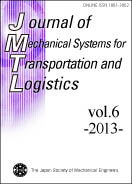Current issue
Displaying 1-7 of 7 articles from this issue
- |<
- <
- 1
- >
- >|
Special Issue on TRANSLOG2012 & J-RAIL2012
-
2013 Volume 6 Issue 2 Pages 89
Published: 2013
Released on J-STAGE: October 31, 2013
Download PDF (147K)
Review
-
2013 Volume 6 Issue 2 Pages 90-99
Published: 2013
Released on J-STAGE: October 31, 2013
Download PDF (1519K)
Papers
-
2013 Volume 6 Issue 2 Pages 100-110
Published: 2013
Released on J-STAGE: October 31, 2013
Download PDF (1023K) -
2013 Volume 6 Issue 2 Pages 111-123
Published: 2013
Released on J-STAGE: October 31, 2013
Download PDF (1694K) -
2013 Volume 6 Issue 2 Pages 124-132
Published: 2013
Released on J-STAGE: October 31, 2013
Download PDF (1181K) -
2013 Volume 6 Issue 2 Pages 133-141
Published: 2013
Released on J-STAGE: October 31, 2013
Download PDF (1662K)
Technical Note
-
2013 Volume 6 Issue 2 Pages 142-149
Published: 2013
Released on J-STAGE: December 26, 2013
Download PDF (964K)
- |<
- <
- 1
- >
- >|
